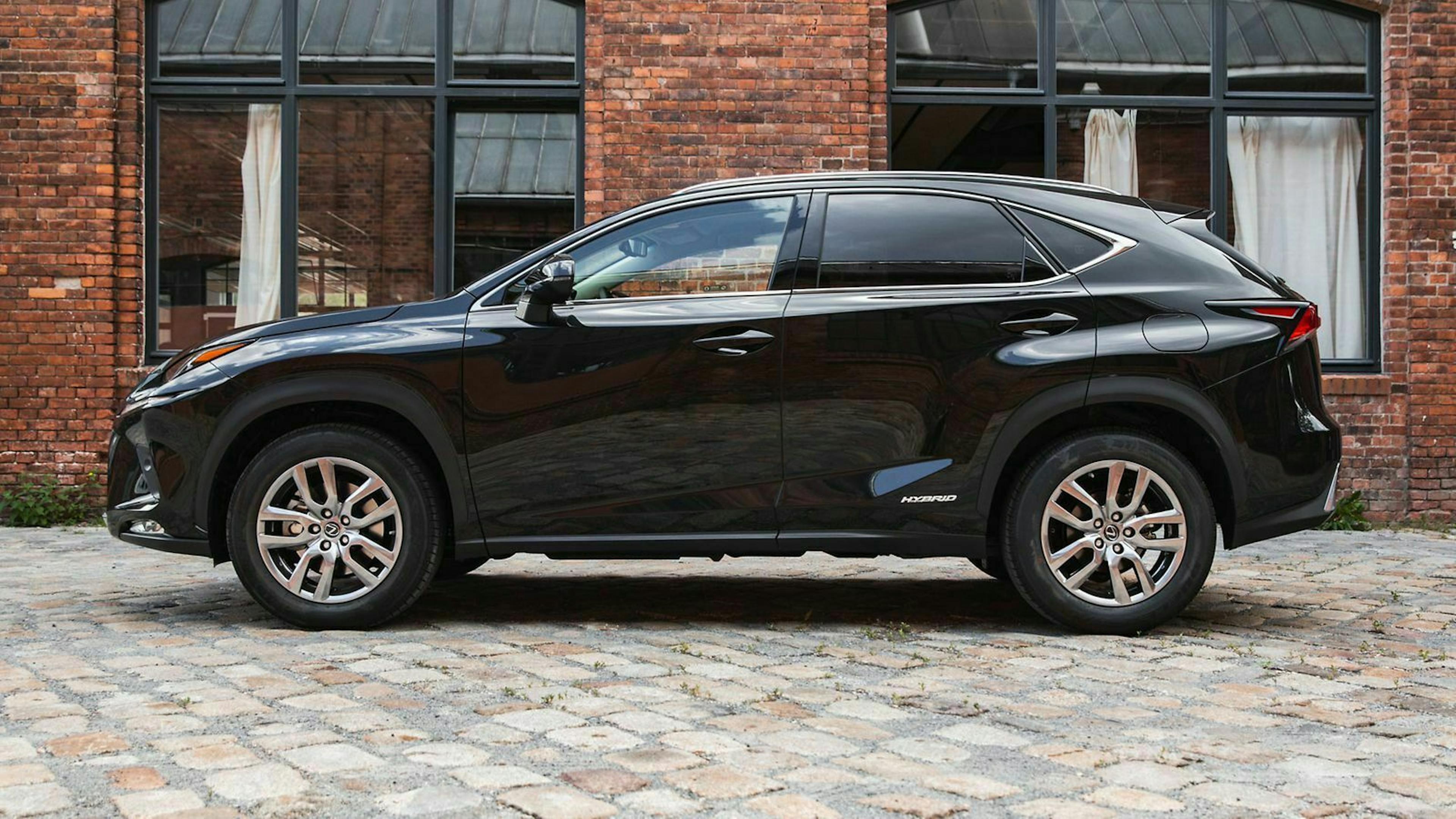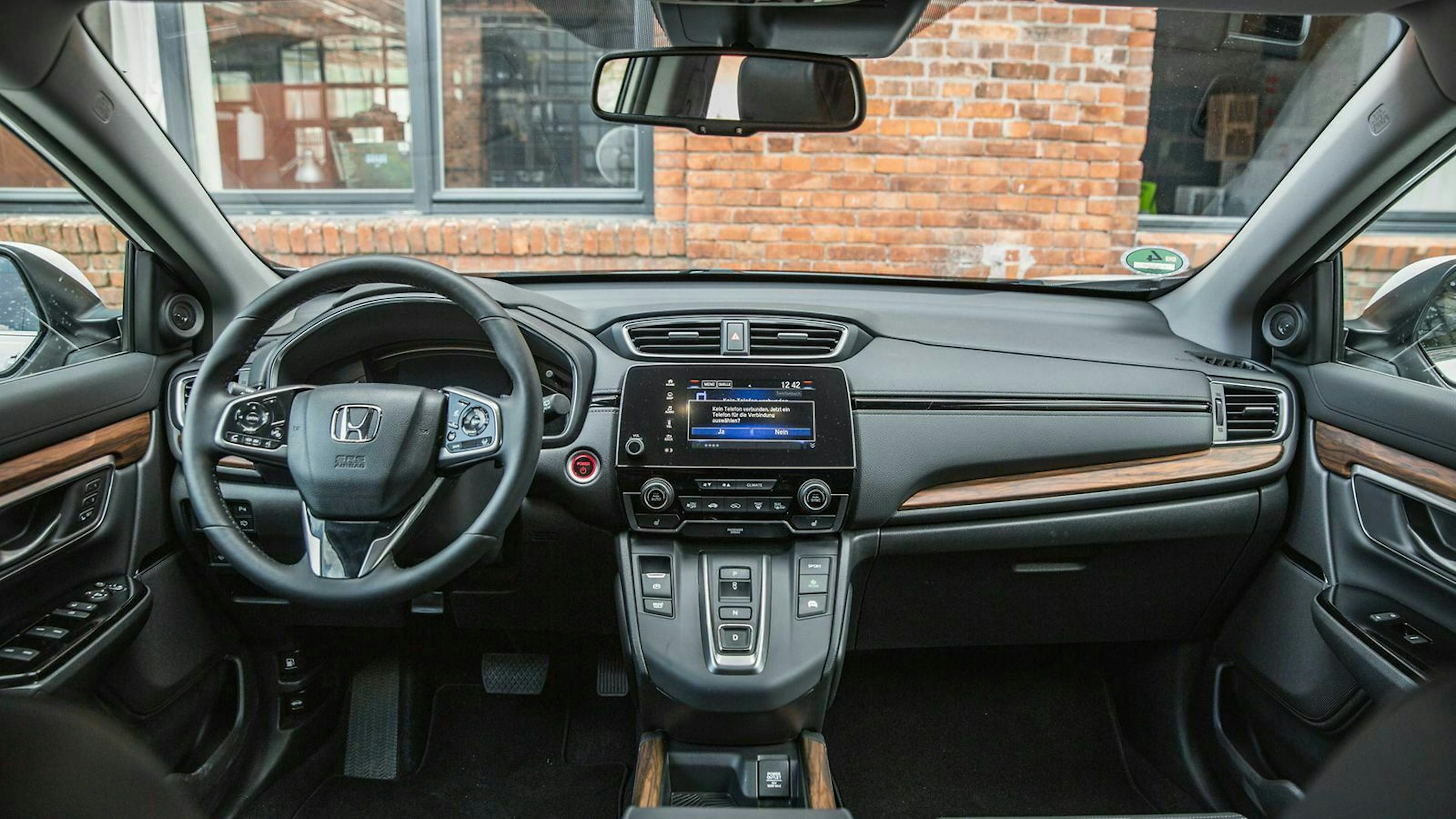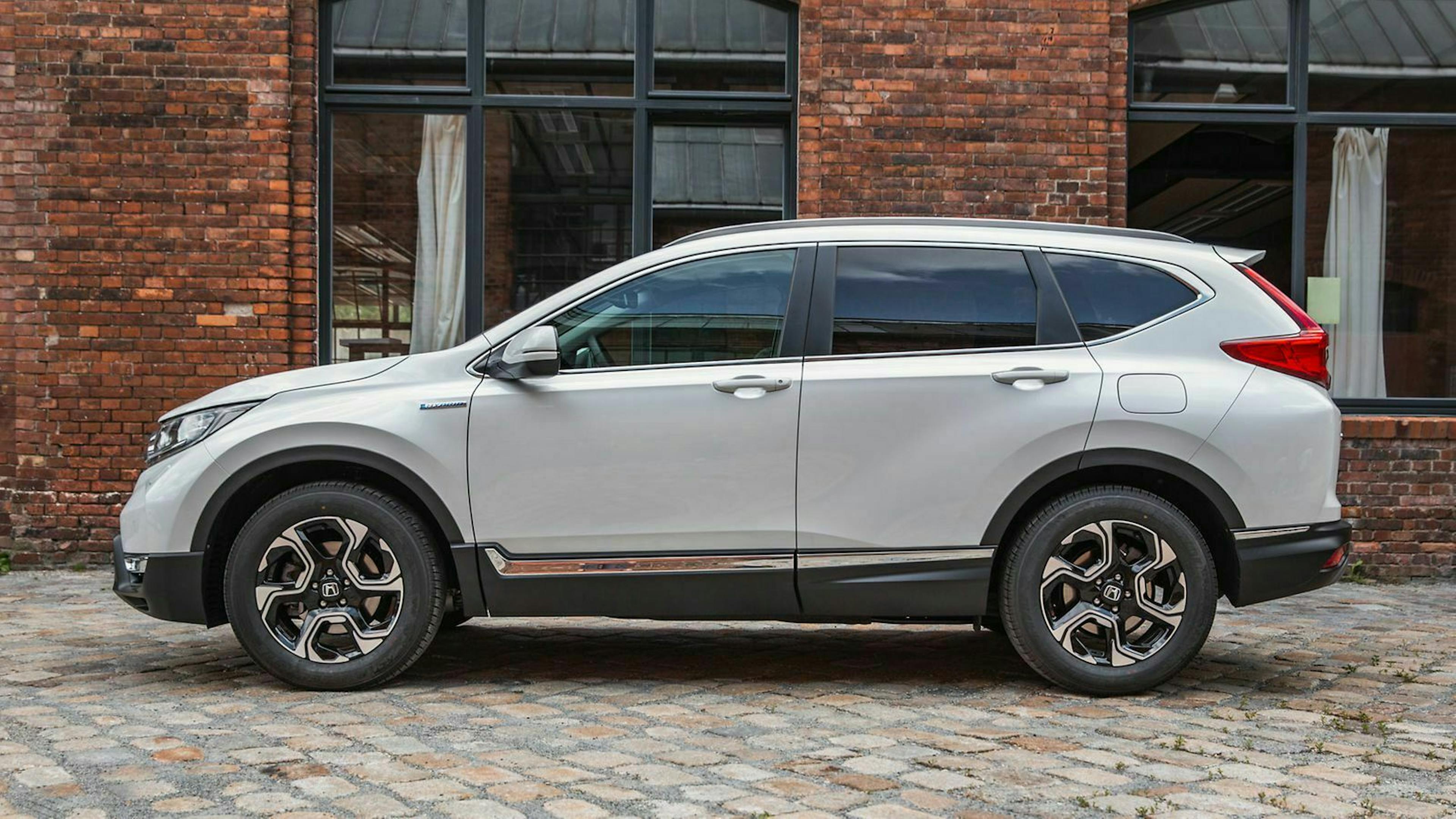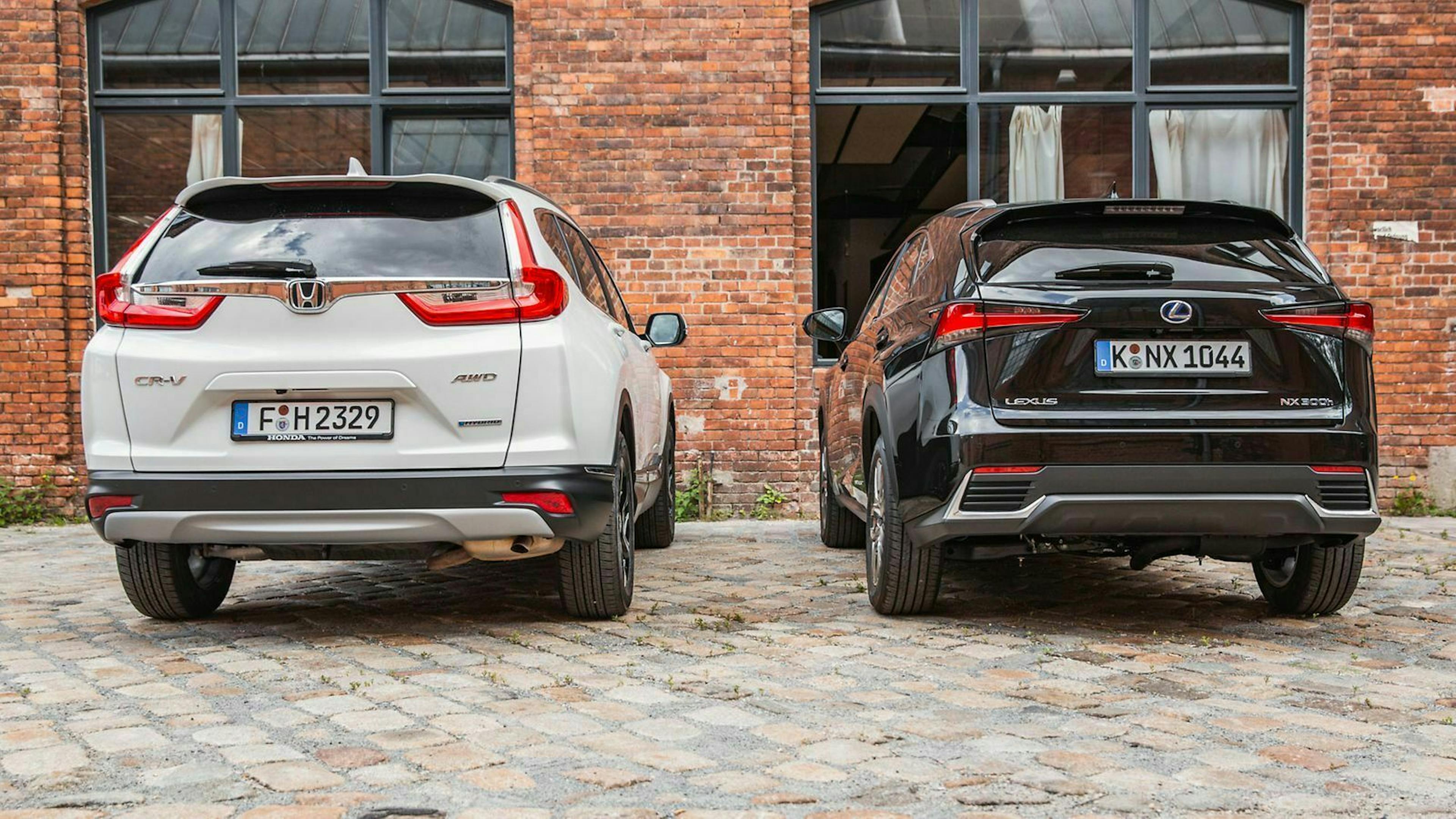Honda CR-V Hybrid and Lexus NX 300h: test, technical data, prices
Hybrid and hybrid don't necessarily mean the same thing. The name only describes the fact that two engines are at work in the car – usually combustion engines and electric vehicles. How they combine their power varies.
For many years, Toyota and Lexus were the measure of all things when it came to hybrid drives. Hardly any could trump Prius and Co in fuel consumption and driving comfort. But that is changing. Other manufacturers dare to come up with other ideas. Honda is building a new interpretation of the full hybrid theme into the CR-V SUV. This much can already be revealed: It's worth taking a closer look. We compared Honda's new part-time electric car to an old-school model: It has to measure itself against the Lexus NX – a luxurious interpretation of the hybrid SUV with Toyota drive. In our detailed evaluation, you can find out which concept works better.
Dimensions, space, body
The SUV hybrids come with some parallels: strong stature and Asian origin. In terms of length, they are about the same, the Lexus stretches its angular nose three centimeters further forward. But it is much more obstructed. You could also say: tighter in terms of sport. Although that should not be the claim for an SUV.

Four people still ride comfortably. It sits generously at the front and rear. However, the Japanese does not feel as airy as the CR-V. This also applies to the trunk. There is a huge storage compartment under the loading floor in the Lexus, but not in the Honda – so despite similar numbers of liters, the Honda offers the much more usable trunk.
Especially when it comes to storage, the Honda offers more. Its huge center console easily stows the contents of a larger handbag or a large water bottle. Lexus installs this area with controls, next to it there is less space for drinks and knick-knacks. Also great about the Honda: The center tunnel is extremely flat and takes up little footroom.
Interior, workmanship, materials
Narrow compartments are the price of a lot of design. The noble Lexus is a designer piece. Here, many functions get their own button, the inclined center console looks great and can be easily reached. In our test car, pretty leather stretches on most of the trim parts. A soft shelf supports the wrist when operating the touchpad for the infotainment system. Nice detail: A removable make-up mirror is elegantly embedded in the center console.
Honda makes the CR-V more businesslike, downright conservative in comparison. There are also pretty seams on the dashboard here, but the elegant wood turns out to be a loveless imitation. Honda is also off the mark on some controls. They are curiously shaped, and their functions are sometimes poorly thought out. Nice detail: Upholstery on the center console ensures that the knees do not rub against the hard plastic. On the other hand, the Lexus does not have any hard plastic at this point. It looks more chic and elegant overall - and thus meets its premium claim.
Infotainment, radio, connectivity
Unfortunately, the Lexus is lagging behind technically. Its infotainment system noticeably comes from an old generation. The operation via touchpad succeeds after a few attempts, but is a disaster in many situations. The self-evident Android Auto and Apple CarPlay standards are not available in the Lexus. So you have to rely on the factory functions.
Honda builds a touch system into the CR-V, but forgets intuitive menu navigation. The choice of radio stations and navigation inputs are unnecessarily complicated and quickly annoying. At least you can switch to the mobile phone without positioning it in the field of vision: It navigates better with mirrored apps on the car display.

Both manufacturers urgently need to catch up when it comes to infotainment. Most of the important functions are at least available, but difficult to access, unattractively displayed or generally poorly implemented. The Toyota Group already has more up-to-date systems, and many things will improve with the replacement of the NX. The CR-V is actually too new for the impression it gives.
Assistance systems and safety
When it comes to assistance, the Honda shows a head start – and the company's strategy of offering many helpers as standard. A large assistance system is in every model. However, parking aids, reversing camera and blind spot warning are only available in higher equipment variants. Lexus offers a considerable range for its age, but does not keep up with Honda, especially not in the base.
The adaptive cruise control systems work smoothly and reliably in both cars. However, you should not rely on the Traffic Sign Assist in the Honda. For example, when driving on the motorway, he reads limits for exits on which you don't drive at all. The fact that Lexus does not offer one at all in the NX is not a negative thing. The lane departure warning system in the Honda corrects significantly, but in the Lexus it steers only gently.
Drive, motor, gearbox
Despite the similarity in the name, the biggest difference is under the hood. Toyota's classic full hybrid technology works in the Lexus: a large gasoline engine with excellent efficiency, coupled to an electric motor that supports it. A variable CVT transmission transmits the power of both drives to the axle, including high-revving howls. This principle has worked perfectly since the first Prius. This changes little in the Lexus, although much more power is pending. In the all-wheel-drive version tested, an electric motor is added to the rear axle.

Honda does its own thing. The drive works almost exclusively electrically, the combustion engine generates electricity via a generator, and a battery temporarily stores when needed. Only in a few operating states does the naturally aspirated gasoline engine physically drive the axle. If it does, then via a fixed gear ratio - there are no multiple gears.
This makes the CR-V feel like an electric car. It starts with a spontaneous moment and purrs forward strongly, but with noticeable weight. If the stored electricity becomes scarce, the combustion engine starts up and charges the battery. You rarely feel any of this, the 2.0-liter naturally aspirated gasoline engine usually runs cultivated and quiet. Only when the power decrease increases does it turn up audibly. The all-wheel drive works classically via a cardan shaft.
In the Lexus, you can also feel the powerful torque of the electric motor when starting off. It helps the SUV to overcome its inertia and get moving. Shortly afterwards, both work together (full throttle) or alternately. Both cars capture energy when braking and store it in the battery. Apart from that, they feel completely different: electric versus combined power, rare versus frequent engine howling. On paper, they are similarly fast, but the Lexus feels more agile.
Which technology works better? We are surprised ourselves: The Honda convinces. On the one hand, because it always drove half a liter to one and a half liters more economically during our test phase. On the other hand, because its characteristics can be better combined with the European sense of noise comfort. At this point, it should be mentioned that the Toyota Group already has a successor to the Lexus drive, just not yet in the aged NX.

In absolute terms, both cars are economical - measured against the usual thirst of stocky SUVs. The Honda commuted to the surrounding area with an average consumption of 5.2 liters per 100 kilometers and could be driven in the city with 5.5 liters. The Lexus injected 5.8 and 6.8 liters respectively. Attention: Both models get thirsty at high speeds. If you drive a lot on the motorway, it is better to invest in a diesel. This inevitably means a different car, for both Japanese there are no diesel engines on offer.
Handling, chassis, steering
In the general vote, the picture turns. Honda designs the CR-V to be spongy to cumbersome. Its mass is clearly noticeable, unfavorably reinforced by the moderate steering. There is a lack of precision and weight in the valance. It cannot compensate for this even with its brisk acceleration without shift pauses.
Anyone who switches to the Lexus thinks it is nervous at first. In fact, however, it has the muscles that the Honda lacks. The NX steers and springs noticeably more grippy, it sways and nods less. It feels a bit more like sport, without actually demanding the term "sporty". Nevertheless, this seems a bit synthetic.
Both cars have the usual SUV weaknesses, which are firmly linked to the design. These include a high center of gravity and audible wind noise at high speeds. In addition, you can feel how the steering impulse arrives first in the wheels, then in the body. Lexus offers an adaptive suspension as an option. It is not available at Honda.
Features and price
Japanese "premium" versus Japanese "mainstream": The Honda CR-V is available at a more attractive price. As a hybrid, it starts at 32,790 euros. In the tested Executive equipment with all-wheel drive (unnecessary on the road), the price rises to 44,290 euros. Important extras and assistants are on board as standard, including the "Sensing" package with lane departure warning, adaptive cruise control, (nervous) collision warning and traffic sign recognition.
Honda builds a Bluetooth connection into every CR-V. Due to the moderate usability, the smartphone connection via cable is recommended. These are available as standard from the Elegance equipment line (base price: 35,690 euros), but not for money and good words in the basic version. According to the list, the tested variant costs 44,910 euros.
Lexus is pricing the NX much more confidently. The hybrid base costs 42,000 euros, the all-wheel drive 1,700 euros extra. Then only the most necessary details are on board, at least including Bluetooth CD radio. The tested "Executive Line" comes with a large display, keyless go, inductive charging, leather seats and a reversing camera. The price rises to 50,250 euros.
With other optional extras, including paint, navigation system with larger screen, adaptive cruise control, LED lamps and lane departure warning (only warning, not corrective), the total price rises to 54,050 euros. A price gap that corresponds to Lexus' brand positioning.
Result
Nevertheless, the winner in the comparison is - clearly - Honda CR-V Hybrid. It costs 10,000 euros less, is better equipped, drives more economically and more pleasantly. The Lexus sometimes moves more agilely and is more elegant and high-quality in the interior. However, these advantages only partially justify the high surcharge for the car, which is no longer dewy in terms of design. However, a close relative could do better: The Toyota Rav-4 Hybrid is the natural competitor of the Honda. It is based on the current Toyota base and is closer in price. For regular, brisk long-distance journeys, hybrids are generally not the first choice. In a mixed driving profile, however, they can be the most economical and pleasant drive – especially in a heavy SUV.
Honda CR-V and Lexus NX 300h: Technical Specifications
| Model | Honda CR-V 2.0 i-MMD Hybrid AWD | Lexus NX 300h E-Four |
|---|---|---|
| Gas | 2.0-liter Atkinson gasoline engine | 2.5-liter Atkinson gasoline engine |
| Hybridization | Electric motor | Electric motors |
| Performance combustion engine | 145 hp (107 kW) at 6,200 rpm | 155 hp (114 kW) at 5,700 rpm |
| Front electric motor power | 184 hp (135 kW) | 143 hp (105 kW) |
| Rear electric motor power | - | 68 hp (50 kW) |
| Torque combustion engine | 175 Nm at 4,000 rpm | 210 Nm at 4,200 - 4,400 rpm |
| Torque electric motor at the front | 315 Nm | 270 Nm |
| Rear electric motor torque | - | 139 Nm |
| Performance | 184 hp (135 kW) | 197 hp (145 kW) |
| System torque | 315 Nm | n/a |
| Transmission | Fixed translation | E-CVT |
| Maximum speed | 180 km/h | 180 km/h |
| Acceleration 0 – 100 km/h | 9.2 s | 9.2 s |
| Fuel consumption (WLTP) | 5.5 l/100 km | 5.2 l/100 km |
| CO2 emissions (WLTP) | 120 g/km | 121 g/km |
| Test Consumption | 5.2 l/100 km | 5.8 l/100 km |
| Length | 4,600 mm | 4,630 mm |
| Width | 1,855 mm | 1,845 mm |
| Width with exterior mirrors | 2,117 mm | 2,130 mm |
| Height | 1,679 mm | 1,645 mm |
| Wheelbase | 2,662 mm | 2,660 mm |
| Trunk volume | 497 – 1,692 l | 555 – 1,600 l |
| Base price | 32,790 euros (2.0 i-MMD Hybrid) | 42,000 euros (NX 300h) |
| Test car price | 44,910 euros | 54,050 euros |
